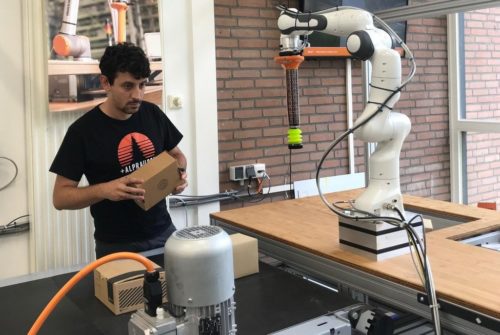Researchers at TU/e have devised a method for producing flexible, thin, and precise sensor electronics that can help robots detect humans.

“Many industrial operations require close human-robot interactions”, says researcher Marco Fattori from the department of Electrical Engineering and the TU/e startup MicroAlign. “This means that the robots need accurate proximity sensors to check if someone gets too close to the robot. Once someone is detected, the robot shuts down to prevent any injuries to the person.”
Many of today’s sensors are made of silicon components, which are hard and thick, making placement on the robot’s surface challenging and expensive. “The alternative is flexible printed electronics, but this kind of electronics has lower capabilities compared to silicon chips,” notes Eugenio Cantatore from the department of Electrical Engineering. “Flexible electronics are slow and noisy, which negatively affects its accuracy. But unlike silicon sensors, the flexible ones can be placed over large surface areas, are cheap to make, and can be produced in large quantities.”
So, in partnership with researchers from France, Austria, and the United Kingdom, Fattori and Cantatore developed novel flexible electronics made by printing organic materials based on polymers to overcome the problem of manufacturing precise flexible electronics. The printing method enables the device’s front-end electronics (the first electronics layer following the sensor) to be placed in each pixel.
“In effect, we printed electronics on a plastic or foil sheet, then we placed the sensors on another foil. After that we laminated the two foils together, leading to an ultra-flexible and thin sensor,” says Fattori. “This combination enhances signal quality in comparison to previous sensors.”
The researchers used long-wavelength infrared organic pyroelectric sensors (heat sensors) in the flexible foil for this experiment. “We created a large flexible sheet filled with heat sensors that can be used to cover a structure, such as a robotic arm for example,” says Cantatare. To recreate an industrial work environment where a person works near to a robot, they put a flexible sheet of heat sensors around a robotic arm.
“The flexible sensor acts like a sort of ‘artificial skin’ for the robot. The heat sensors allow the robot to detect the presence of a moveable heat source, such as a person, from a distance of up to 0.4 meters away,” notes Fattori. “What’s more, the sensors can also detect a human hand approaching from different directions and not just from directly in front of it.”
Click here to access their paper.






